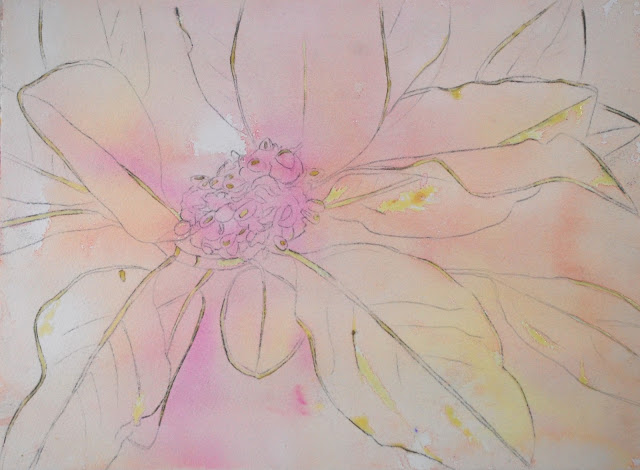 |
| Colored pencil on dark. I start with white and do a value study. |
 |
| I then cover all the white in canary yellow. I left things unfinished for demonstration purposes. |
 |
| Colored pencil on dark. I start with white and do a value study. |
 |
| I then cover all the white in canary yellow. I left things unfinished for demonstration purposes. |
 |
| I worked a little more on the petals and the shadows on the leaves. |
 |
| I darkened the background (so now need to fix the edges of the ornaments), added more pine needles, and shaded the snow a bit more. |
 |
| We worked on the right side of the body and the head. It still needs work on the head, it needs darks and details. And a little more on the body. |
 |
| CP on UART sanded pastel paper. Added more darks, color, and details. Used indigo, true blue, white, and black for the beak. Added cream as well. |
 |
| I started working on some of the leaves and the petals adding shadows. I also demonstrated lifting with a wet brush and a scrubber brush. |
 |
| Acrylic on paper. Worked on the troublesome drips a bit more as well as adjusting the values a little bit |
 |
| Worked on the leaves and petals a bit more, adding some shadows. |
 |
| Worked on the leaves and petals, adding more shadow and color as well as some detail. |
 |
| Acrylic on paper. Still refining. |
 |
| Acrylic on paper. Started the cows, painting the values. |
 |
| Colored pencil over a textured background on cold press watercolor paper. I have refined a little more and added some more detail. It needs more work before being complete. |
 |
| Pouring. This is after the first masking and the first pour with yellow, orange, and red. |
 |
| This is a light textured under painting and background for the mushroom. I used light color and plastic wrap. |
 |
| Transfer the drawing and mask out the lightest areas. The paper is taped to a board for support. |
 |
| Sprayed the paper with water. Poured with red, orange, and yellow, very light color mixed with water in a small jar. |
 |
| Sprayed the paper with water. Poured using red, orange, and yellow in specific areas. Can use a pipette here if you wish. |
 |
| Started painting areas with a watercolor brush. Have not removed the masking yet, that will come after the first round of direct painting. |
 |
| Acrylic. Wet-on-dry upright. Using thinned red, we painted the first pass on the radish. |
 |
| We started working on the flower petals. I used white, pomegranate, true blue, and a little bit of indigo. |
 |
| I worked more on the face, adding some shadows. I also worked more on the head scarf. |
 |
| I aded some shadows and the stem as well as the center of the flower. It all needs more work og course. |
 |
| I worked on adding shadows and details to the cow. He needs a little more work. |
 |
| Acrylic. I added a little dark around the flower to pop it forward. I did a little more with the white, adding highlights. |
 |
| I started working on the petals and added a leaf I had missed. |